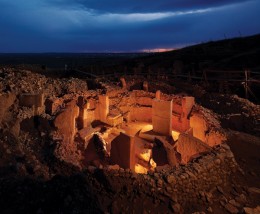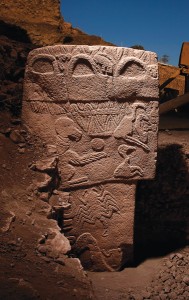Is Turkey’s “Stonehenge” evidence of the oldest religion in the world?


The massive stone enclosures of the Göbekli Tepe ruins (known to many as Turkey’s “Stonehenge”) may be the earliest examples of Neolithic religion. What do the enclosures and the fascinating reliefs that adorn their pillars reveal about the oldest religion in the world? Photo: Vincent J. Musi/National Geographic Stock.
On a hill known as Göbekli Tepe (“Potbelly Hill”) in southeastern Turkey, excavations led by Klaus Schmidt uncovered several large megalithic enclosures that date between 10,000 and 8000 B.C.E., the dawn of civilization and the Neolithic age. Each of these circular enclosures, which many have described as Turkey’s “Stonehenge,” consists of 10 to 12 massive stone pillars surrounding two larger monoliths positioned in the middle of the structure. There are no village remains at or near the Göbekli Tepe ruins, suggesting that the unique site was a ceremonial center exclusively used for the practice of the Neolithic religion of local hunter-gatherer groups.
Given the early age of the site, equally surprising are the varied and often highly elaborate carvings that adorn the pillars of the Göbekli Tepe ruins. Among the pillars are detailed and often very realistic depictions of animal figures, including vultures and scorpions, lions, bulls, boars, foxes, gazelles, asses, snakes and other birds and reptiles. In addition, some of the massive monoliths are carved with stylized anthropomorphic details—including arms, legs and clothing—that give the impression of large super-human beings watching over the enclosures.
Our free eBook Ten Top Biblical Archaeology Discoveries brings together the exciting worlds of archaeology and the Bible! Learn the fascinating insights gained from artifacts and ruins, like the Pool of Siloam in Jerusalem, where the Gospel of John says Jesus miraculously restored the sight of the blind man, and the Tel Dan inscription—the first historical evidence of King David outside the Bible.


Despite the primitive age of the sanctuary at Göbekli Tepe, the carvings reflect a high level of artisanship depicting a plethora of animal figures in both low and high relief, including vultures and scorpions (shown here), lions, bulls, boars, foxes, gazelles, asses, snakes, other birds and reptiles. Photo: Vincent J. Musi/National Geographic Stock.
The Göbekli Tepe ruins and enclosures—the earliest monumental ritual sites of Neolithic religion and possibly the oldest religion in the world—are causing experts to rethink the origins of religion and human civilization. Until recently, scholars agreed that agriculture and human settlement in villages gave rise to religious practices. The discoveries at the Göbekli Tepe ruins, however, indicate that earlier hunter-gatherer groups that had not yet settled down had already developed complex religious ideas, together with monumental ceremonial sites to practice the sacred communal rituals of Neolithic religion.
Indeed, excavations at the Göbekli Tepe ruins uncovered tens of thousands of animal bones, indicating that many different species—including those depicted on the pillars—were slaughtered, sacrificed and presumably eaten at the site. While it is uncertain to whom these sacrifices were made, it’s possible they were offered to the enclosures’ stylized human pillars that, as some have suggested, may represent priests, deities or revered ancestors in Neolithic religion. Given that human bones were also been found, others believe the Göbekli Tepe ruins may have been a Neolithic burial ground where funerary rituals and perhaps even excarnations were practiced.*
To learn more about the Göbekli Tepe ruins and Neolithic religion, read Ben Witherington III’s article “In the Beginning: Religion at the Dawn of Civilization” as it appears in the January/February 2013 issue of Biblical Archaeology Review.
Not a BAS Library member yet? Sign up today.
Our free eBook Ten Top Biblical Archaeology Discoveries brings together the exciting worlds of archaeology and the Bible! Learn the fascinating insights gained from artifacts and ruins, like the Pool of Siloam in Jerusalem, where the Gospel of John says Jesus miraculously restored the sight of the blind man, and the Tel Dan inscription—the first historical evidence of King David outside the Bible.
Notes:
* For excarnation in the later Chalcolithic period, see Rami Arav, “Excarnation: Food For Vultures,” Biblical Archaeology Review, November/December 2011.
Related content in Bible History Daily:
The Prehistoric Diet and the Rise of Complex Societies
No Matches? No Problem. Ancient Fire-Making in Israel
Çatalhöyük Mural: The Earliest Representation of a Volcanic Eruption?
Journey to the Copper Age: A Video Lecture by Thomas E. Levy
This Bible History Daily feature was originally published in December 2012.
Get more biblical Archaeology: Become a Member
The world of the Bible is knowable. We can learn about the society where the ancient Israelites, and later Jesus and the Apostles, lived through the modern discoveries that provide us clues.
Biblical Archaeology Review is the guide on that fascinating journey. Here is your ticket to join us as we discover more and more about the biblical world and its people.
Each issue of Biblical Archaeology Review features lavishly illustrated and easy-to-understand articles such as:
• Fascinating finds from the Hebrew Bible and New Testament periods
• The latest scholarship by the world’s greatest archaeologists and distinguished scholars
• Stunning color photographs, informative maps, and diagrams
• BAR’s unique departments such as First Person and Strata
• Reviews of the latest books on biblical archaeology
The BAS Digital Library includes:
• 45+ years of Biblical Archaeology Review
• 20+ years of Bible Review online, providing critical interpretations of biblical texts
• 8 years of Archaeology Odyssey online, exploring the ancient roots of the Western world in a scholarly and entertaining way,
• The New Encyclopedia of Archaeological Excavations in the Holy Land
• Video lectures from world-renowned experts.
• Full online access to 50+ curated Special Collections,
• Four highly acclaimed books, published in conjunction with the Smithsonian Institution: Aspects of Monotheism, Feminist Approaches to the Bible, The Rise of Ancient Israel and The Search for Jesus.
The All-Access membership pass is the way to get to know the Bible through biblical archaeology.

